Middle-Term Evolution of Efficiency in Permeable Pavements: A Real Case Study in a Mediterranean climate
Abstract
1. Introduction
2. Materials and Methods
2.1. Site Description
2.2. Analysis of Data
- Least-squares. The values obtained in the three pavements are close to 0, so the adjustment of this variable is considered optimal [42].
- Nash-Sutcliffe efficiency coefficient. The medians obtained are 0.82, 0.83, and 0.72 for pavements P1, P2, and P3, respectively. According to Molnar [43], this adjustment is considered to be excellent for P1 and P2 pavements and very good for P3 pavements.
- Correlation coefficient. The medians obtained are 0.91, 0.68, and 0.78 for P1, P2, and P3 pavements, respectively. These values are above 0.6, so the adjustment is considered to be good [44].
3. Results
3.1. Hydrologic Performance
- Runoff. All events analyzed have produced runoff on P0; however, only 17% have generated runoff on P1 and 22% on P2, with values close to 1 mm, demonstrating that these pavements have been able to infiltrate almost all the precipitation. On P3, the runoff has only appeared in 3% of the events since it is a granular pavement and, therefore, has the highest water absorption and retention capacity.According to the historical series of precipitations in the area, in all three pavements, the runoff has not appeared in events with return-periods of less than 20 years, which indicates these systems are particularly suitable in climates, such as the Mediterranean, where the rains generate many service problems in the streets due to the water accumulation.
- Drainage volume (VD). A regression analysis has been carried out, showing that the drainage volume is clearly lower than the rainfall volume (VR) in all three permeable pavements (Figure 4). The difference between the two volumes corresponds to the evapotranspiration water stored in the sub-base/pavement assembly. This figure also shows that pavements P1 and P3 have very similar behavior and that pavement P2 is the one that stores the most water. The black line represents the behavior of pavement P0 that drains practically all the water it receives. As shown, all the events recorded are above this line, which indicates that permeable pavements have stored water in all the events, considerably reducing the amount of water that goes to the drainage network.
- Drainage time (TD). The increase in drainage time (compared with P0) in P1 is, on average, 394%, 429% in P2, and 366% in P3, which again indicates its great water retention capacity (Figure 3). Figure 5 shows a regression analysis where the drainage time is shown to be significantly higher than the rainfall time (TR) in all three permeable pavements. The values obtained are very similar among themselves, with the pavement P2 as the one with the longest drainage time.The broken line in Figure 5 represents the behavior of the impervious pavement that drains practically all the water at the same time as it receives it. The data points to the left of the black line indicate that the rainfall time (TR) has been greater than the drainage time (TD). This occurs because the drainage has not occurred; that is, the water has been retained in the soil. Almost all the events recorded are below this line, which indicates that the pavements continue to drain water long after the rain has stopped. This shows the buffering capacity of these pavements.
- Peak flow. Permeable pavements have generated lower peak flows than impermeable pavements (Figure 3). The average peak flow of P1 is 10% of P0, 4% of P2, and 7% of P3. Eighty-three percent of the events have generated a peak flow of less than 0.1 l/s in P1, less than 96% in P2, and less than 85% in P3. This shows that the hydrological behavior of permeable pavements is very stable during rain events, which has direct repercussions on the operation of the sewerage network, making it work in a much better way and significantly reducing flooding episodes.
3.2. Evaluation of the Efficiency Evolution
3.2.1. Pavement P1
3.2.2. Pavement P2
3.2.3. Pavement P3
3.3. Influence of Soil Water Saturation on Efficiency
- Pavement P2 (green) is the one that presents the lowest saturation values since it is a less porous pavement composed of sand.
- Pavement P3 (orange) is the one that presents higher saturation values since it is the most porous pavement composed of gravel.
- All three pavements achieve efficiencies above 0.65 in 95% of the events analyzed.
- All three pavements generate efficiency of around 0.8 at the moment of maximum saturation.
- The correlation results obtained have been validated with coefficients of determination R2 between 0.693 and 0.862.
4. Discussion
5. Conclusions
Author Contributions
Funding
Acknowledgments
Conflicts of Interest
References
- Pistocchi, A.; Calzolari, C.; Malucelli, F.; Ungaro, F. Soil sealing and flood risks in the plains of Emilia-Romagna, Italy. J. Hydrol. Reg. Stud. 2015, 4, 398–409. [Google Scholar] [CrossRef]
- European Commission. Guidelines on Best Practice to Limit, Mitigate or Compensate Soil Sealing; Commission Staff Working Document. Available online: http://ec.europa.eu/environment/soil/pdf/soil_sealing_guidelines_en.pdf (accessed on 5 October 2015).
- Fini, A.; Frangi, P.; Mori, J.; Donzelli, D.; Ferrini, F. Nature based solutions to mitigate soil sealing in urban areas: Results from a 4-year study comparing permeable, porous, and impermeable pavements. Environ. Res. 2017, 156, 443–454. [Google Scholar] [CrossRef] [PubMed]
- Scalenghe, R.; Marsan, F.A. The anthropogenic sealing of soils in urban areas. Landsc. Urban Plan. 2009, 90, 1–10. [Google Scholar] [CrossRef]
- Tóth, G.; Montanarella, L.; Rusco, E. Threats to Soil Quality in Europe; Joint Research Centre: Luxembourg, 2008. [Google Scholar]
- Arnfield, A.J. Two decades of urban climate research: A review of turbulence, exchanges of energy and water, and the urban heat island. Int. J. Clim. 2003, 23, 1–26. [Google Scholar] [CrossRef]
- Burns, M.J.; Fletcher, T.D.; Walsh, C.J.; Ladson, A.R.; Hatt, B.E. Hydrologic shortcomings of conventional urban stormwater management and opportunities for reform. Landsc. Urban Plan. 2012, 105, 230–240. [Google Scholar] [CrossRef]
- Burton, G.A., Jr.; Pitt, R. Stormwater Effects Handbook: A Toolbox for Watershed Managers, Scientists, and Engineers; Lewis Publisher: London, UK, 2001. [Google Scholar]
- Shuster, W.D.; Bonta, J.; Thurston, H.; Warnemuende, E.; Smith, D.R. Impacts of impervious surface on watershed hydrology: A review. Urban Water J. 2005, 2, 263–275. [Google Scholar] [CrossRef]
- Semadeni-Davies, A.; Hernebring, C.; Svensson, G.; Gustafsson, L.-G. The impacts of climate change and urbanisation on drainage in Helsingborg, Sweden: Combined sewer system. J. Hydrol. 2008, 350, 100–113. [Google Scholar] [CrossRef]
- Zhou, Q. A Review of Sustainable Urban Drainage Systems Considering the Climate Change and Urbanization Impacts. Water 2014, 6, 976–992. [Google Scholar] [CrossRef]
- Palla, A.; Gnecco, I. Hydrologic modeling of Low Impact Development systems at the urban catchment scale. J. Hydrol. 2015, 528, 361–368. [Google Scholar] [CrossRef]
- Woods-Ballard, B.; Wilson, S.; Udale-Clarke, H.; Illman, S.; Scott, T.; Ashley, R.; Kellagher, R. The SuDS Manual; CIRIA: London, UK, 2015. [Google Scholar]
- Ahiablame, L.M.; Engel, B.A.; Chaubey, I. Effectiveness of Low Impact Development Practices: Literature Review and Suggestions for Future Research. Water Air Soil Poll. 2012, 223, 4253–4273. [Google Scholar] [CrossRef]
- Bressy, A.; Gromaire, M.; Lorgeoux, C.; Saad, M.; Leroy, F.; Chebbo, G. Efficiency of source control systems for reducing runoff pollutant loads: Feedback on experimental catchments within Paris conurbation. Water Res. 2014, 57, 234–246. [Google Scholar] [CrossRef] [PubMed]
- Charlesworth, S.; Perales-Momparler, S.; Lashford, C.; Warwick, F. The sustainable management of surface water at the building scale: Preliminary results of case studies in the UK and Spain. J. Water Supply Res. Technol. 2013, 62, 534–544. [Google Scholar] [CrossRef]
- Norton, B.A.; Coutts, A.M.; Livesley, S.J.; Harris, R.J.; Hunter, A.M.; Williams, N.S. Planning for cooler cities: A framework to prioritise green infrastructure to mitigate high temperatures in urban landscapes. Landsc. Urban Plan. 2015, 134, 127–138. [Google Scholar] [CrossRef]
- Rodríguez, M.I.; Cuevas, M.M.; Huertas, F.; Martinez, G.; Moreno, B. Indicators to evaluate water sensitive urban design in urban planning. WIT Transact. Built Environ. 2015, 1, 371–382. [Google Scholar] [CrossRef]
- Barbosa, A.; Fernandes, J.; David, L. Key issues for sustainable urban stormwater management. Water Res. 2012, 46, 6787–6798. [Google Scholar] [CrossRef] [PubMed]
- Fletcher, T.D.; Shuster, W.; Hunt, W.F.; Ashley, R.; Butler, D.; Arthur, S.; Trowsdale, S.; Barraud, S.; Semadeni-Davies, A.; Bertrand-Krajewski, J.-L.; et al. SUDS, LID, BMPs, WSUD and more—The evolution and application of terminology surrounding urban drainage. Urban Water J. 2014, 12, 525–542. [Google Scholar] [CrossRef]
- Cettner, A.; Ashley, R.; Viklander, M.; Nilsson, K. Stormwater management and urban planning: Lessons from 40 years of innovation. J. Environ. Plan. Manag. 2013, 56, 786–801. [Google Scholar] [CrossRef]
- Lundy, L.; Wade, R. Integrating sciences to sustain urban ecosystem services. Prog. Phys. Geogr. Earth Environ. 2011, 35, 653–669. [Google Scholar] [CrossRef]
- Newman, R.; Ashley, R.; Cettner, A.; Viklander, M. The role of context in framing discourses in the transition from piped to sustainable stormwater systems. In Proceedings of the NOVATECH 2013, Lyon, France, 23–27 June 2013. [Google Scholar]
- Roy, A.H.; Wenger, S.J.; Fletcher, T.D.; Walsh, C.J.; Ladson, A.R.; Shuster, W.D.; Thurston, H.W.; Brown, R.R. Impediments and Solutions to Sustainable, Watershed-Scale Urban Stormwater Management: Lessons from Australia and the United States. Environ. Manag. 2008, 42, 344–359. [Google Scholar] [CrossRef]
- Brown, R.A.; Borst, M. Quantifying evaporation in a permeable pavement system. Hydrol. Process. 2014, 29, 2100–2111. [Google Scholar] [CrossRef]
- Hunt, D.V.L.; Rogers, C. Barriers to sustainable infrastructure in urban regeneration. Proc. Inst. Civ. Eng. Eng. Sustain. 2005, 158, 67–81. [Google Scholar] [CrossRef]
- Perales-Momparler, S.; Andrés-Domenech, I.; Andreu, J.; Escuder-Bueno, I. A regenerative urban stormwater management methodology: The journey of a Mediterranean city. J. Clean. Prod. 2015, 109, 174–189. [Google Scholar] [CrossRef]
- McLaughlin, A.-M.; Charlesworth, S.; Coupe, S.; de Miguel, E. Resilience and sustainable drainage: End-of-life. In Proceedings of the NOVATECH 2016, Lyon, France, 28–30 June 2016. [Google Scholar]
- Sañudo-Fontaneda, L.; Andrés-Valeri, V.C.; Costales-Campa, C.; Cabezon-Jimenez, I.; Cadenas-Fernandez, F. The Long-Term Hydrological Performance of Permeable Pavement Systems in Northern Spain: An Approach to the “End-of-Life” Concept. Water 2018, 10, 497. [Google Scholar] [CrossRef]
- Braswell, A.S.; Winston, R.J.; Hunt, W.F. Hydrologic and water quality performance of permeable pavement with internal water storage over a clay soil in Durham, North Carolina. J. Environ. Manag. 2018, 224, 277–287. [Google Scholar] [CrossRef] [PubMed]
- Liu, Y.; Li, T.; Yu, L. Urban heat island mitigation and hydrology performance of innovative permeable pavement: A pilot-scale study. J. Clean. Prod. 2020, 244, 118938. [Google Scholar] [CrossRef]
- Selbig, W.R.; Buer, N.H.; Danz, M.E. Stormwater-quality performance of lined permeable pavement systems. J. Environ. Manag. 2019, 251, 109510. [Google Scholar] [CrossRef]
- Lucke, T.; Beecham, S. Field investigation of clogging in a permeable pavement system. Build. Res. Inf. 2011, 39, 603–615. [Google Scholar] [CrossRef]
- Nichols, P.D.; Lucke, T. A Detailed Analysis of Sediment Particle Sizes and Clogging in Permeable Pavements. CLEAN Soil Air Water 2017, 45, 1700078. [Google Scholar] [CrossRef]
- Kumar, K.; Kozak, J.; Hundal, L.; Cox, A.; Zhang, H.; Granato, T. In-situ infiltration performance of different permeable pavements in a employee used parking lot—A four-year study. J. Environ. Manag. 2016, 167, 8–14. [Google Scholar] [CrossRef]
- Boogaard, F.; Lucke, T.; Beecham, S. Effect of Age of Permeable Pavements on Their Infiltration Function. CLEAN Soil Air Water 2013, 42, 146–152. [Google Scholar] [CrossRef]
- Rodríguez-Rojas, M.; Huertas-Fernández, F.; Moreno, B.; Martínez, G.; Grindlay, A. A study of the application of permeable pavements as a sustainable technique for the mitigation of soil sealing in cities: A case study in the south of Spain. J. Environ. Manag. 2018, 205, 151–162. [Google Scholar] [CrossRef] [PubMed]
- USDA. Urban Hydrology for Small Watersheds, 2nd ed.; Conservation Engineering Division: Washington, DC, USA, 1986.
- AEMET, Agencia Estatal de Meteorología de España. Registros Climáticos. Available online: http://www.aemet.es/es/idi/clima/registros_climaticos (accessed on 1 November 2019).
- United States environmental protection agency. Filtr. Sep. 1999, 36, 41. [CrossRef]
- Rossman, L.A. Storm Water Management Model User’s Manual Version 5.0; National Risk Management Research Laboratory: Cincinnati, OH, USA, 2010. [Google Scholar]
- National Institute of Standards and Technology. Specifications, Tolerances, and Other Technical Requirements for Weighing and Measuring Devices. Available online: https://www.nist.gov/system/files/documents/2017/04/28/hb44-15-web-final.pdf (accessed on 8 November 2015).
- Molnar, P. Calibration. Watershed Modelling; Institute of Environmental Engineering: Zürich, Switzerland, 2011. [Google Scholar]
- Rey, S.J.; Anselin, L. PySAL: A Python Library of Spatial Analytical Methods. In Handbook of Applied Spatial Analysis; Springer International Publishing: Heidelberg, Germany, 2009; pp. 175–193. [Google Scholar]
- Fernández-Barrera, A.H.; Castro-Fresno, D.; Rodriguez-Hernandez, J.; Calzada-Perez, M. Infiltration Capacity Assessment of Urban Pavements Using the LCS Permeameter and the CP Infiltrometer. J. Irrig. Drain. Eng. 2008, 134, 659–665. [Google Scholar] [CrossRef]
- Li, H.; Kayhanian, M.; Harvey, J. Comparative field permeability measurement of permeable pavements using ASTM C1701 and NCAT permeameter methods. J. Environ. Manag. 2013, 118, 144–152. [Google Scholar] [CrossRef] [PubMed]
- Turco, M.; Kodešová, R.; Brunetti, G.; Nikodem, A.; Fér, M.; Piro, P. Unsaturated hydraulic behaviour of a permeable pavement: Laboratory investigation and numerical analysis by using the HYDRUS-2D model. J. Hydrol. 2017, 554, 780–791. [Google Scholar] [CrossRef]
- Huang, J.; He, J.; Valeo, C.; Chu, A. Temporal evolution modeling of hydraulic and water quality performance of permeable pavements. J. Hydrol. 2016, 533, 15–27. [Google Scholar] [CrossRef]
- Kamali, M.; Delkash, M.; Tajrishy, M. Evaluation of permeable pavement responses to urban surface runoff. J. Environ. Manag. 2017, 187, 43–53. [Google Scholar] [CrossRef]
- Brunetti, G.; Šimůnek, J.; Turco, M.; Piro, P. On the use of surrogate-based modeling for the numerical analysis of Low Impact Development techniques. J. Hydrol. 2017, 548, 263–277. [Google Scholar] [CrossRef]

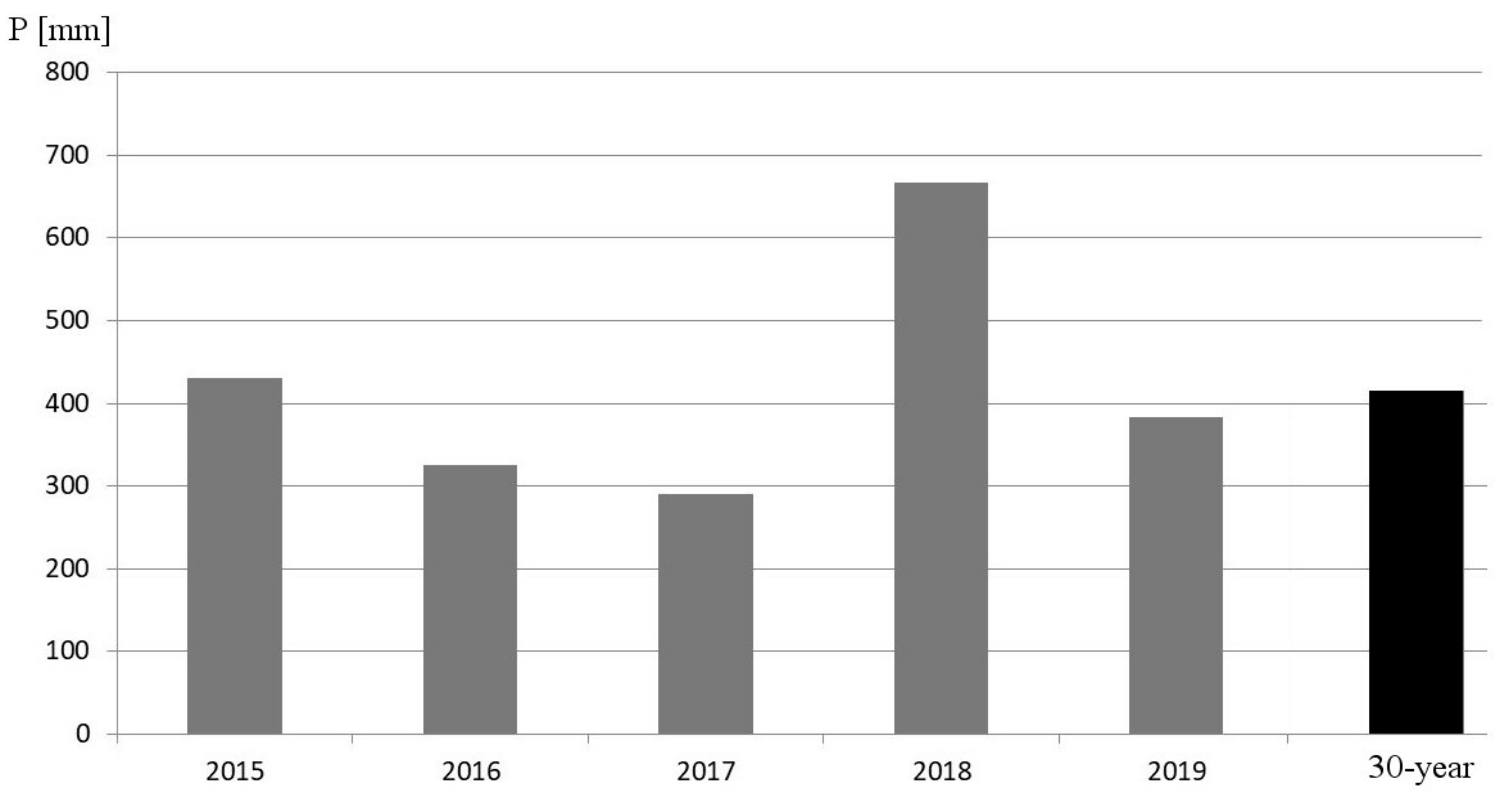
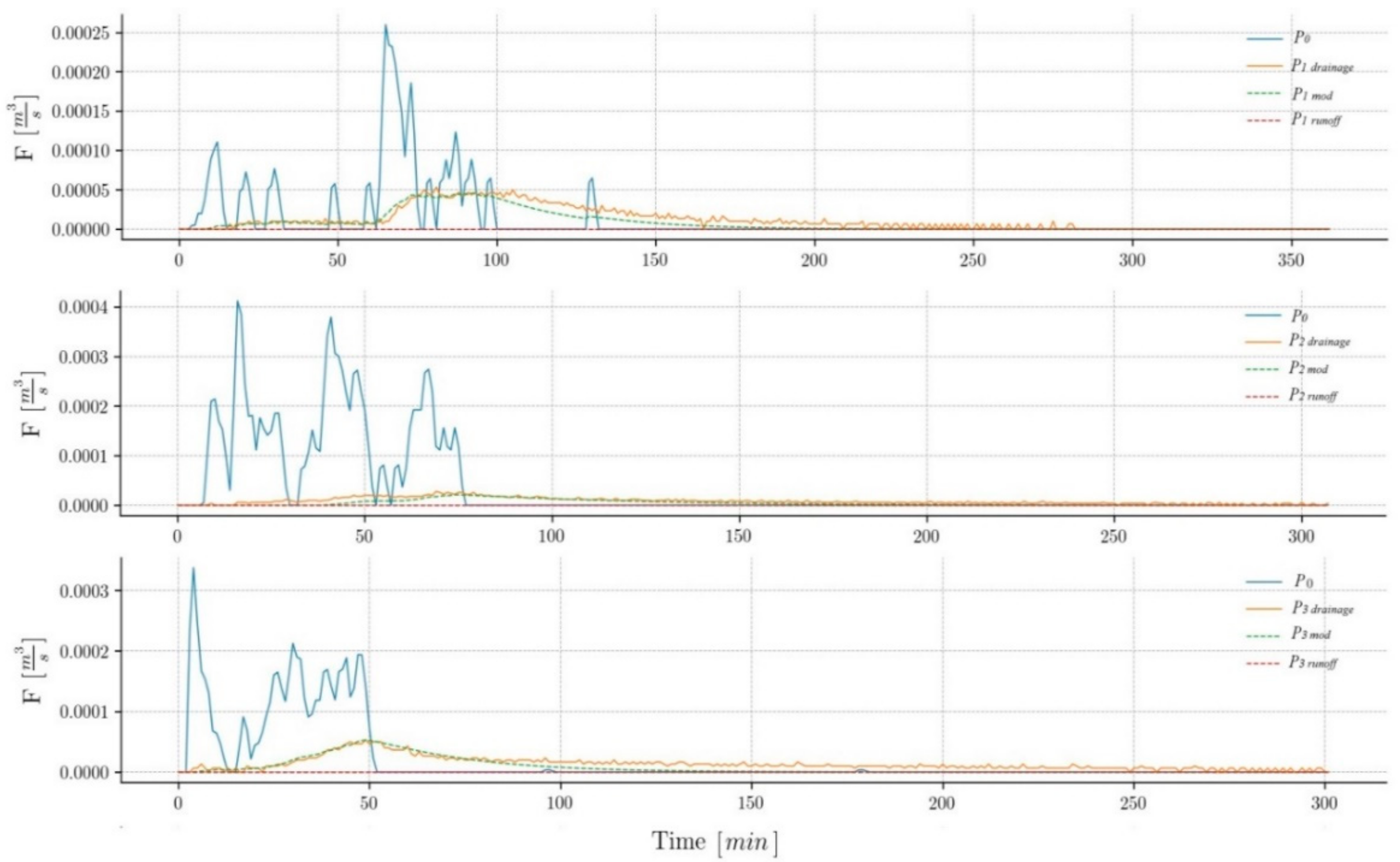
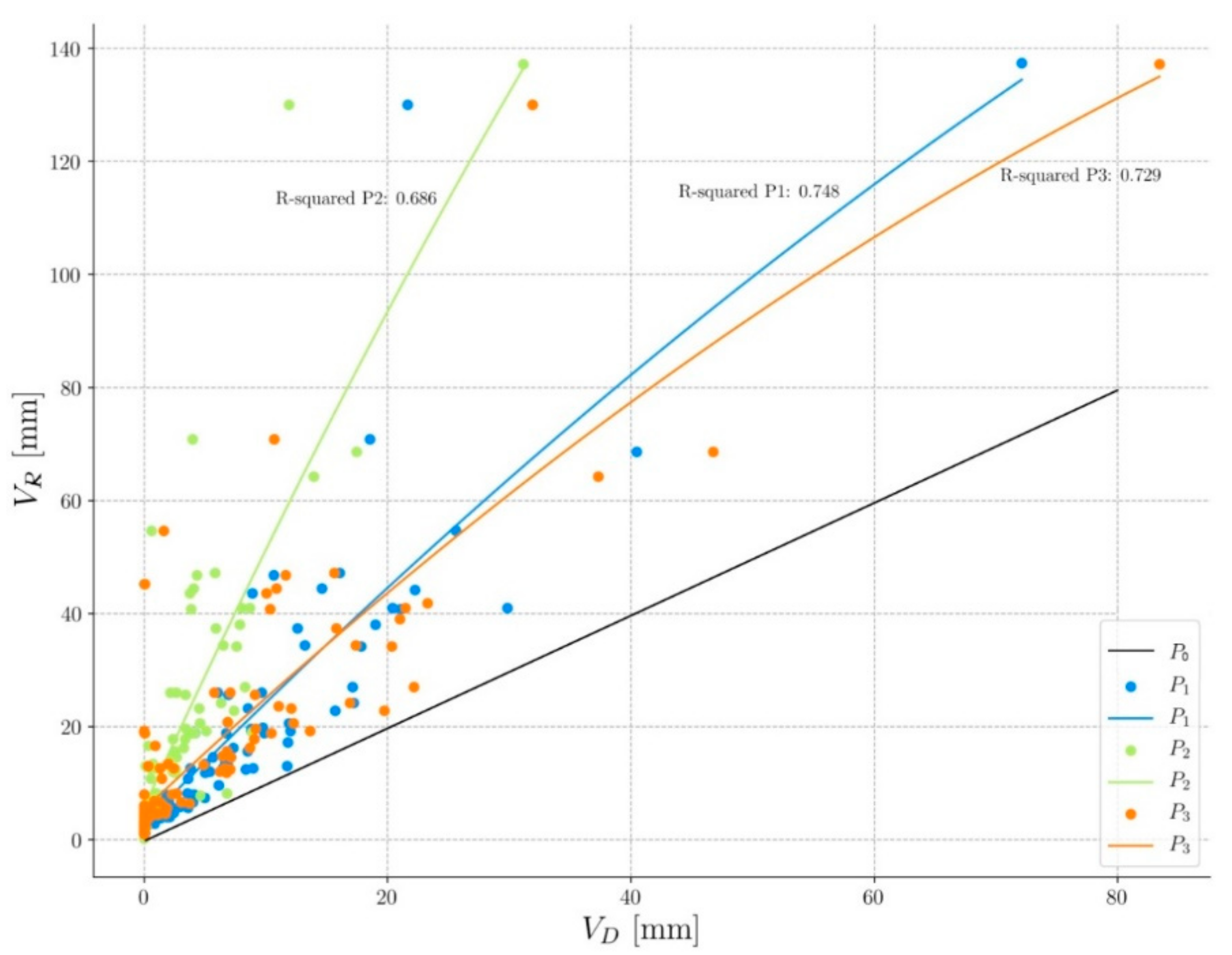
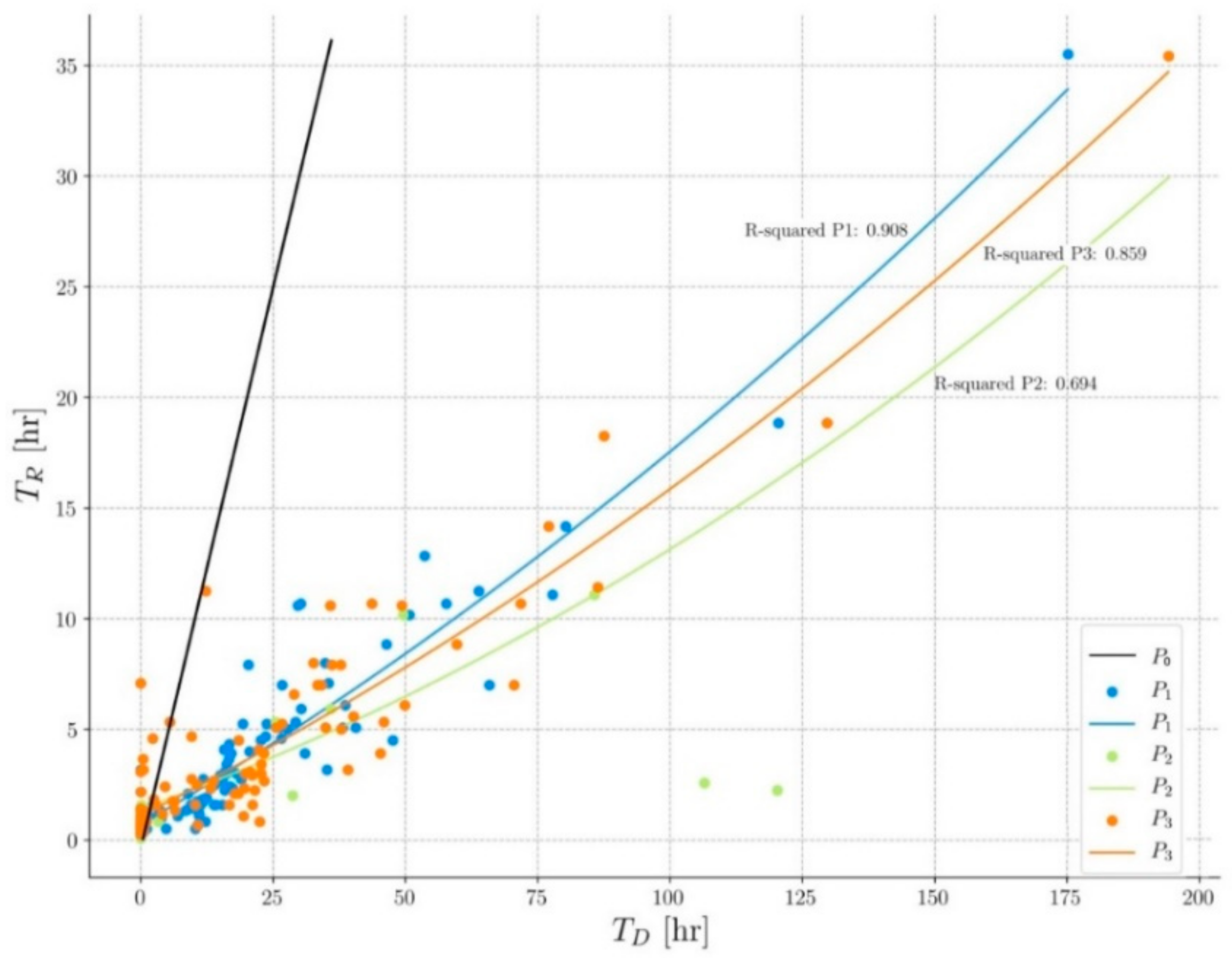
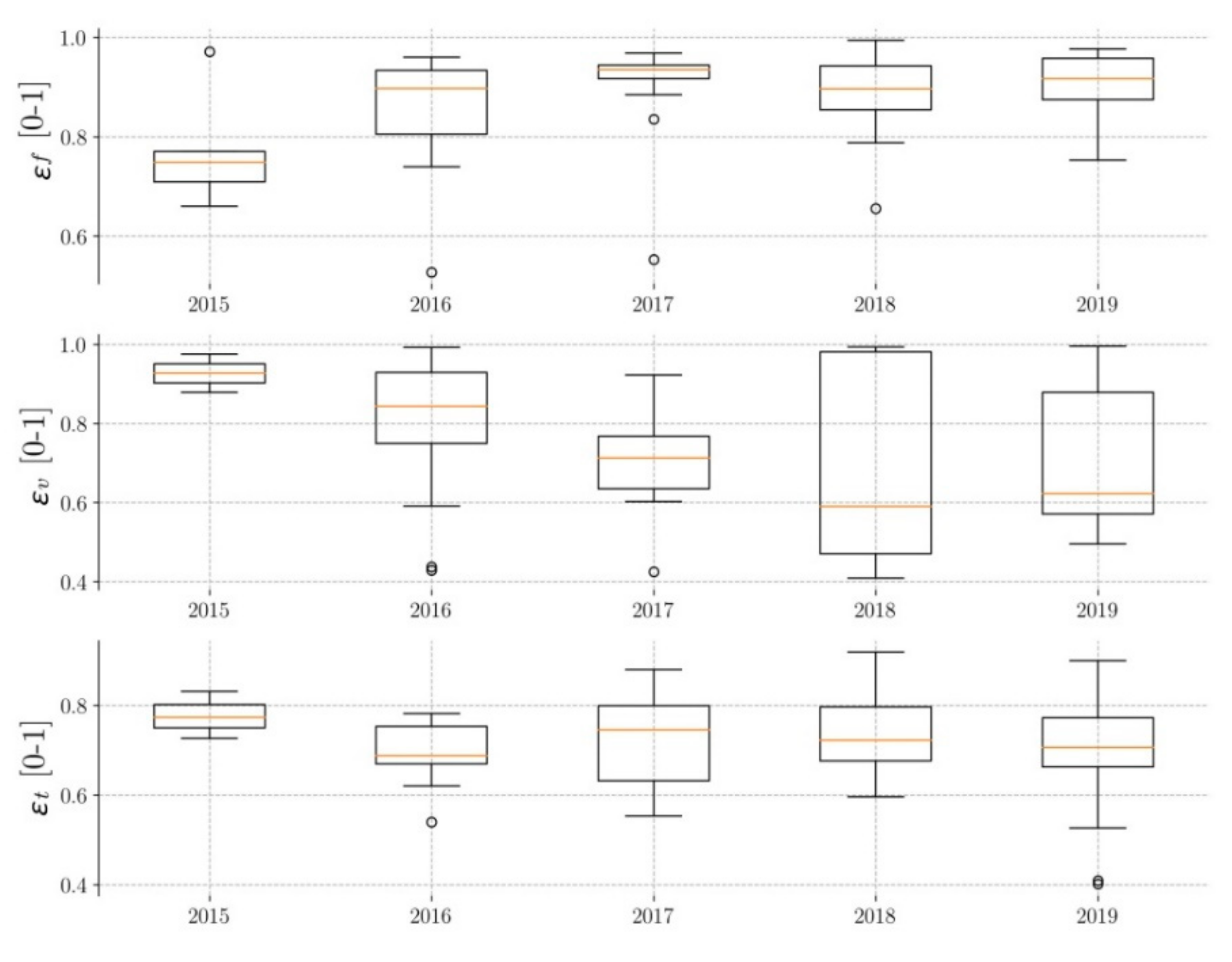
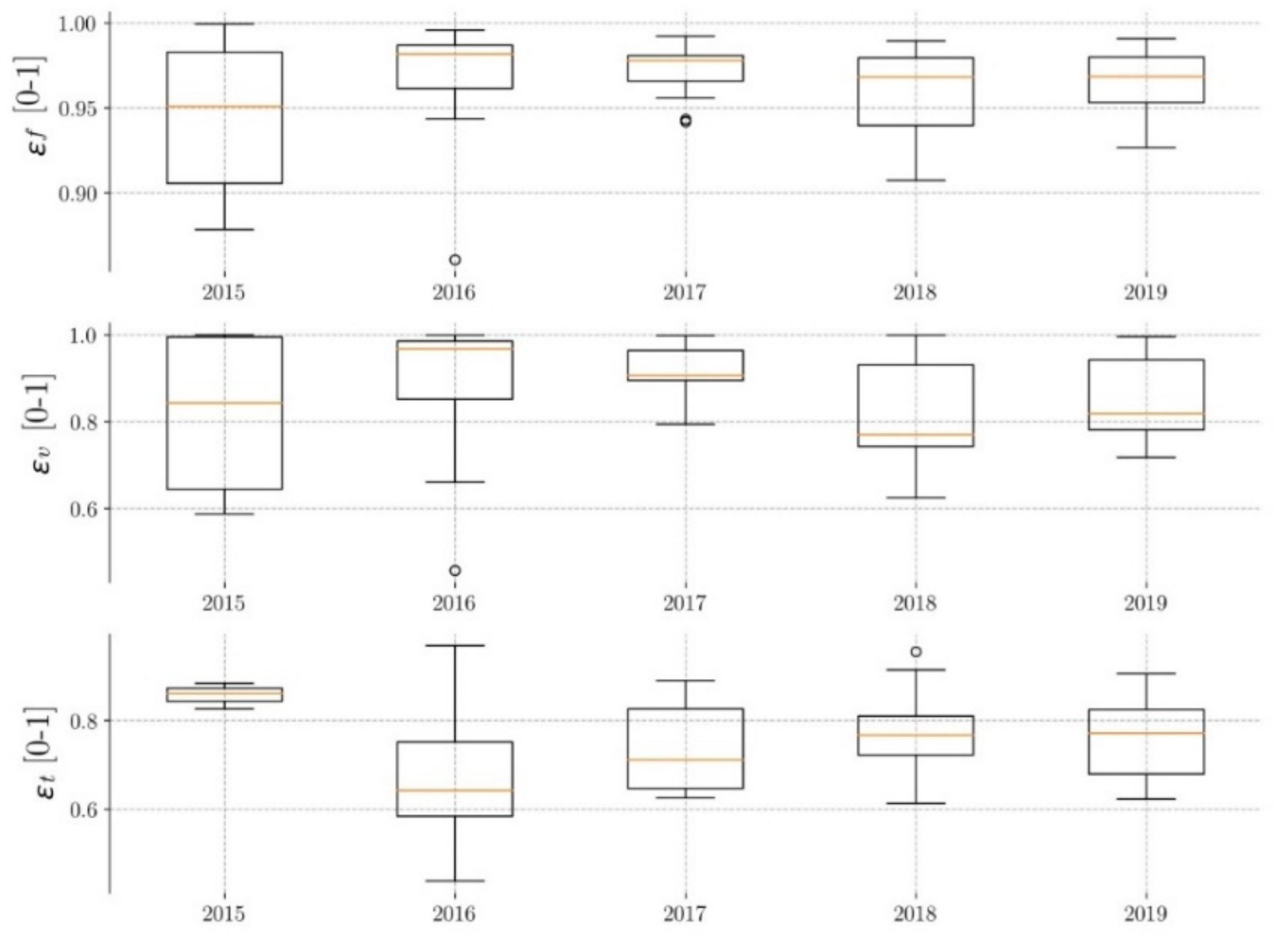
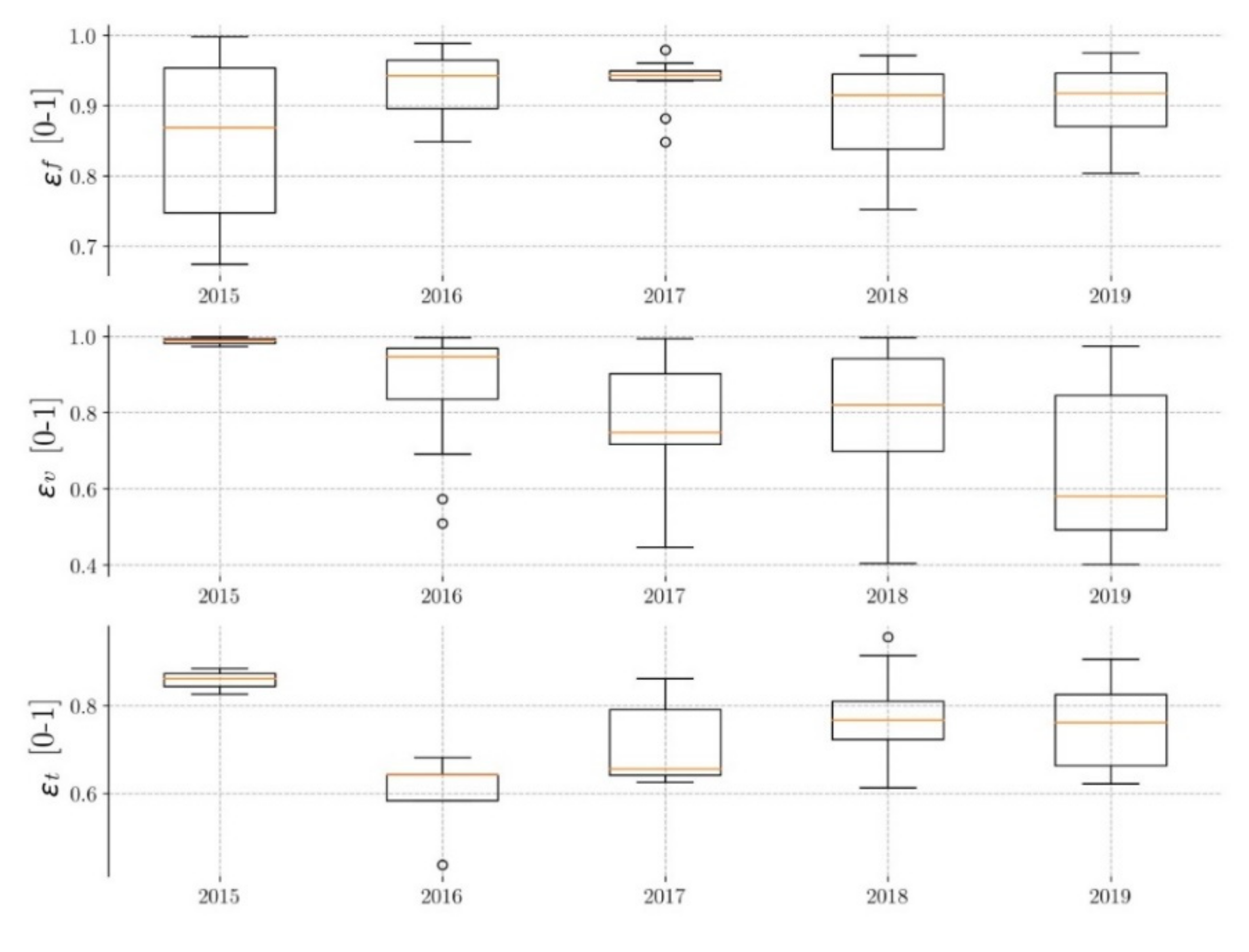
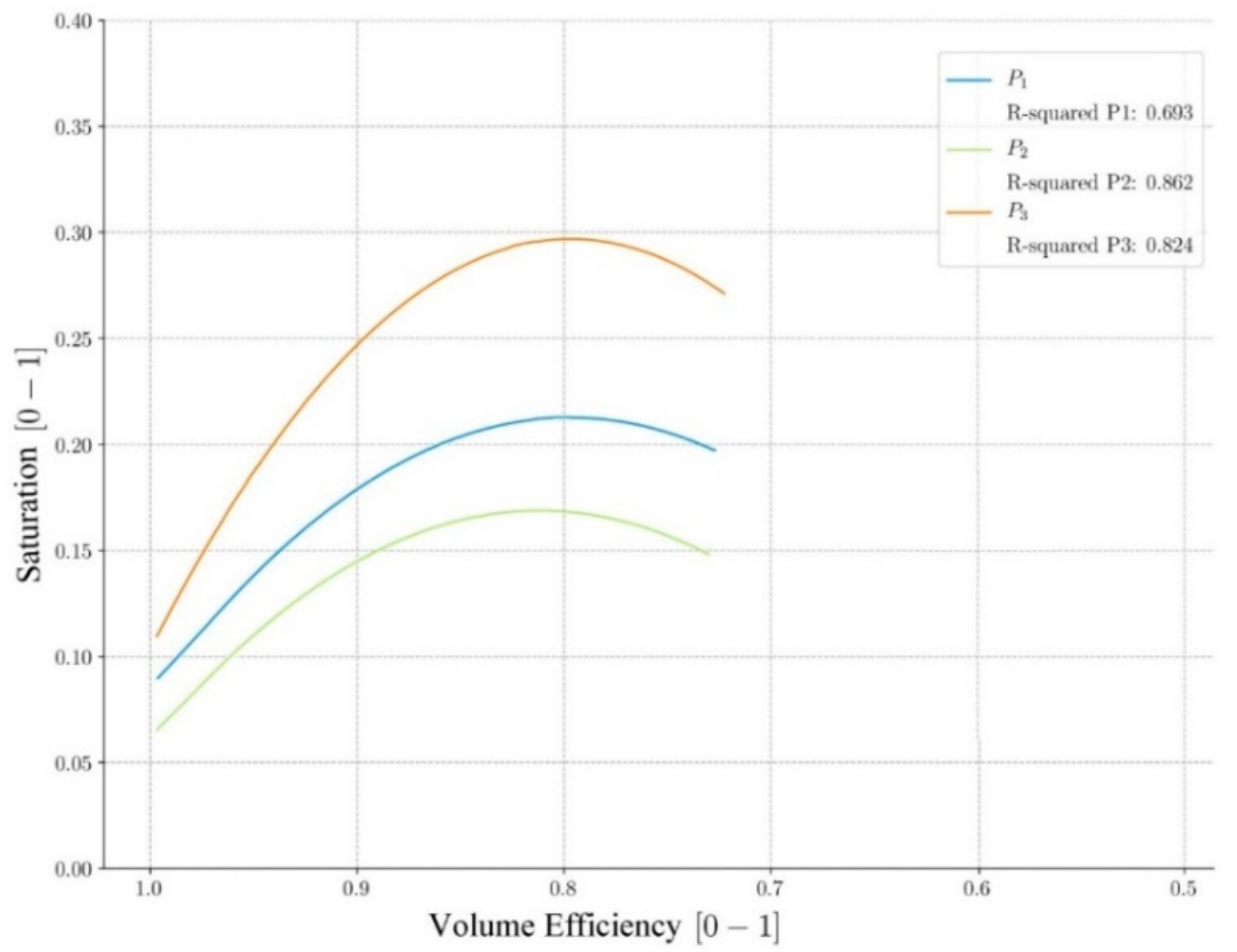
| Characterization Data | P1; Block | P2; Concrete Grid | P3; Plastic Grid |
|---|---|---|---|
| Surface (m2) | 310 | 310 | 193 |
| Curve Number (CN) | 70 | 62 | 60 |
| Rain Events Description | Rainfall Depth (mm) | Intensity (mm/min) | Duration (h) |
|---|---|---|---|
| Maximum value | 137.20 | 1.44 | 35.50 |
| Minimum value | 0.17 | 0.03 | 0.25 |
| Rainfall Depth (mm) Δt = 5 (min) | |
|---|---|
| Average | 0.3714 |
| Median | 0.2000 |
| Standard deviation | 0.4191 |
| Variance | 0.1700 |
| Efficiency Parameter (%) | Definition | Equation |
|---|---|---|
| Time efficiency (ƐT) | Increase in water residence time generated by the permeable pavement compared to a conventional pavement | |
| Flow efficiency (ƐF) | Reduction in peak flow to the sewer system generated by the permeable pavement compared to a conventional pavement | |
| Volume 1 efficiency (ƐV) | Reduction in volume flowing to the sewer system by the permeable pavement compared to a conventional pavement |
| Pavements | Medians Variability (%) | Dispersion Data (%) | ||||
|---|---|---|---|---|---|---|
| ƐF | ƐV | ƐT | ƐF | ƐV | ƐT | |
| P1 | 23 | 56 | 13 | 20 | 60 | 40 |
| P2 | 2 | 26 | 28 | 12 | 40 | 40 |
| P3 | 10 | 98 | 32 | 35 | 60 | 35 |
Publisher’s Note: MDPI stays neutral with regard to jurisdictional claims in published maps and institutional affiliations. |
© 2020 by the authors. Licensee MDPI, Basel, Switzerland. This article is an open access article distributed under the terms and conditions of the Creative Commons Attribution (CC BY) license (http://creativecommons.org/licenses/by/4.0/).
Share and Cite
Rodríguez-Rojas, M.I.; Huertas-Fernández, F.; Moreno, B.; Martínez, G. Middle-Term Evolution of Efficiency in Permeable Pavements: A Real Case Study in a Mediterranean climate. Int. J. Environ. Res. Public Health 2020, 17, 7774. https://doi.org/10.3390/ijerph17217774
Rodríguez-Rojas MI, Huertas-Fernández F, Moreno B, Martínez G. Middle-Term Evolution of Efficiency in Permeable Pavements: A Real Case Study in a Mediterranean climate. International Journal of Environmental Research and Public Health. 2020; 17(21):7774. https://doi.org/10.3390/ijerph17217774
Chicago/Turabian StyleRodríguez-Rojas, M. I., F. Huertas-Fernández, B. Moreno, and G. Martínez. 2020. "Middle-Term Evolution of Efficiency in Permeable Pavements: A Real Case Study in a Mediterranean climate" International Journal of Environmental Research and Public Health 17, no. 21: 7774. https://doi.org/10.3390/ijerph17217774
APA StyleRodríguez-Rojas, M. I., Huertas-Fernández, F., Moreno, B., & Martínez, G. (2020). Middle-Term Evolution of Efficiency in Permeable Pavements: A Real Case Study in a Mediterranean climate. International Journal of Environmental Research and Public Health, 17(21), 7774. https://doi.org/10.3390/ijerph17217774







